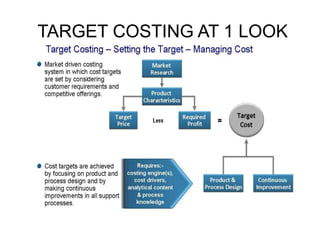
Target Costing
- 1. TARGET COSTING AT 1 LOOK
- 2. WHAT IS TARGET COSTING At first glance, a set of management techniques and calculation methods... ...built around the "key formula" : improve product design and planning till Estimatedcost = target cost Estimatedcost = target selling price - target profit... ...providing market-based cost targets for future products and deploying them to functions, components and parts through analytical methods.
- 3. Target costing works in the opposite way, starting with market share and profit and working back to cost. Establish a product specification Estimate price needed to reach target market share Estimate a target profit to reach a required return on capital Determine the cost needed to reach this target profit. Target costing often results in the identification of a cost gap i.e. current costs are higher than those needed to reach target profits. Management then need to develop strategies to close this gap.
- 4. SELF TEST QUESTION FOR TARGET COSTING CONCEPT A.Whatis a target cost? How is it different from a budgeted cost? A target cost is the allowable amount of cost that can be incurred on a product and still earn the required profit from that product. It is a market driven cost that is computed before a product is produced. A budgeted cost is a predetermined cost after a product is in production. A budget is an operational definition of an allowable cost broken by items and by periods. B. Why is it important to manage costs before products have been produced? Nearly 80% of the costs of many products are committed at the design stage. Therefore, the best opportunity to reduce costs is during design and not after a product is being manufactured. C. At what stage of the product development cycle does target costing play a key role? Target costing occurs within the product development cycle. This means it starts when a product is in its concept stages and ends when a product has been released for manufacturing. D. What is the difference between an allowable cost and an achievable cost? An allowable target cost is the maximum amount that can be spent on a product. An achievable cost is the estimate that tells management whether the product and process design is capable of meeting the allowable cost target.
- 5. Target Costing Is Different From Cost Plus Pricing